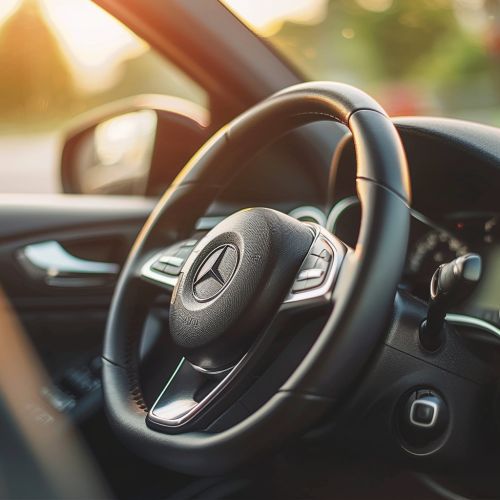Steering
Introduction
Steering is the collection of components, linkages, etc. which allows any vehicle (car, bicycle, ship, aircraft, etc.) to follow the desired course. An exception is the case of rail transport by which rail tracks combined directly with steering function. Steering is also used to describe the action of steering a vehicle.


History
The earliest vehicles did not have an enclosed cabin for the driver, so the mechanism for steering was visible. As vehicles became more complex, the mechanism was built into the vehicle's structure. The first automobiles were steered with a tiller, but in 1894, Alfred Vacheron took part in the Paris–Rouen race with a Panhard 4 hp model which he had fitted with a steering wheel. That is believed to be one of the earliest employments of the principle.
Steering Systems
Steering systems for heavy duty vehicles are different from other types of steering systems, because heavy duty vehicles have a different dynamic due to their size. For example, the steering system for a large ship uses a series of clutches and brakes to change the direction of the ship, while a small boat may use a simple tiller system.
Mechanical Steering Systems
Mechanical steering systems are the most basic type of steering system. They use a series of rods and levers to convert the rotational motion of the steering wheel into a left or right motion of the wheels. The most common type of mechanical steering system is the recirculating ball steering system, which uses a series of ball bearings to reduce friction within the steering system.
Hydraulic Steering Systems
Hydraulic steering systems use a series of hydraulic pumps and cylinders to assist the driver in turning the wheels. When the driver turns the steering wheel, it creates pressure in the hydraulic system, which is then used to turn the wheels. This type of steering system is commonly used in heavy duty vehicles, such as trucks and buses.
Electric Steering Systems
Electric steering systems, also known as power steering systems, use an electric motor to assist the driver in turning the wheels. This type of steering system is becoming increasingly popular due to its efficiency and the fact that it requires less maintenance than hydraulic steering systems.
Electronic Steering Systems
Electronic steering systems, also known as drive-by-wire systems, use a series of sensors and electronic control units (ECUs) to control the steering of a vehicle. These systems are becoming increasingly popular in modern vehicles, as they offer a high level of precision and can be easily integrated with other vehicle systems, such as stability control and lane keeping assist.
Steering Components
The steering system of a vehicle is made up of several key components. These include the steering wheel, the steering column, the steering gear, the steering arms, and the steering linkage.
Steering Wheel
The steering wheel is the component that the driver uses to control the direction of the vehicle. It is connected to the steering system via the steering column.
Steering Column
The steering column is a shaft that connects the steering wheel to the steering gear. It is designed to collapse in a collision to protect the driver from injury.
Steering Gear
The steering gear is the component that converts the rotational motion of the steering wheel into a left or right motion of the wheels. There are several types of steering gears, including the recirculating ball steering gear and the rack and pinion steering gear.
Steering Arms
The steering arms are the components that connect the steering gear to the wheels. They are designed to move in a specific way to ensure that the wheels turn correctly when the steering wheel is turned.
Steering Linkage
The steering linkage is a series of rods and joints that connect the steering gear to the steering arms. It is designed to transfer the motion from the steering gear to the steering arms in a smooth and efficient manner.
Steering Techniques
There are several different techniques that drivers can use to steer a vehicle. These include hand-over-hand steering, push-pull steering, and one-hand steering.
Hand-Over-Hand Steering
Hand-over-hand steering is a technique where the driver uses one hand to pull the steering wheel down while the other hand crosses over to pull the wheel further down. This technique is commonly used when making sharp turns or when maneuvering in tight spaces.
Push-Pull Steering
Push-pull steering is a technique where the driver uses one hand to push the steering wheel up while the other hand pulls the wheel down. This technique is commonly used when driving at high speeds, as it allows for more precise control of the vehicle.
One-Hand Steering
One-hand steering is a technique where the driver uses one hand to steer the vehicle. This technique is commonly used when the driver needs to operate other controls in the vehicle, such as the gear shift or the radio.
